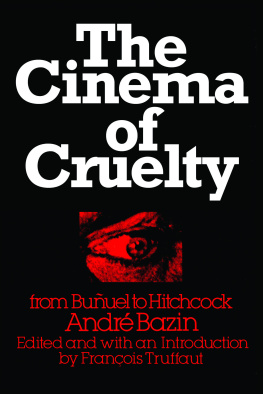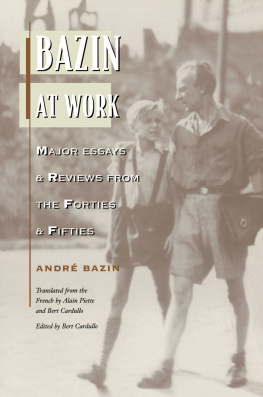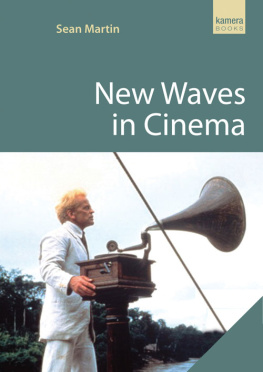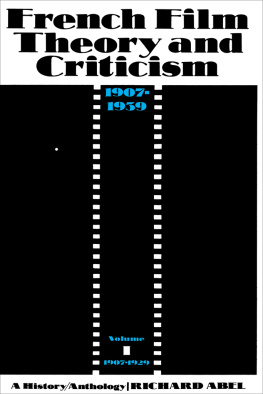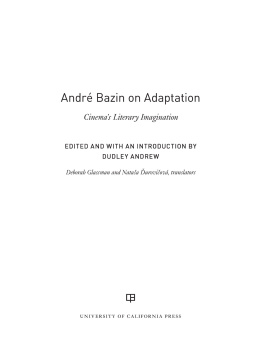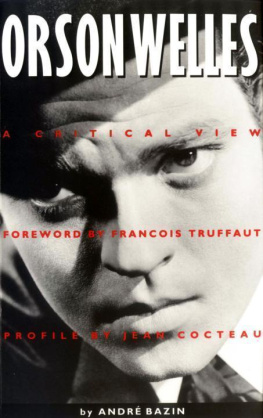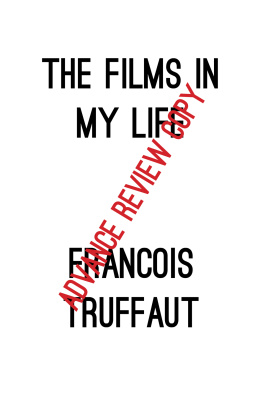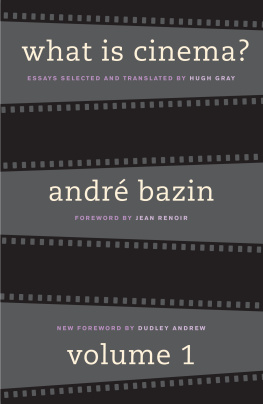
BY THE SAME AUTHOR
What Is Cinema?
Jean Renoir
Charlie Chaplin
Orson Welles
Then French Cinema of Occupation and Resistance

English language translation Copyright 1982, 2013 by Arcade Publishing, Inc.
All Rights Reserved. No part of this book may be reproduced in any manner without the express written consent of the publisher, except in the case of brief excerpts in critical reviews or articles. All inquiries should be addressed to Arcade Publishing, 307 West 36th Street, 11th Floor, New York, NY 10018.
Originally published in 1975 by Editions Flammarion, Paris, France, under the title Le Cinma de la Cruaut
Arcade Publishing books may be purchased in bulk at special discounts for sales promotion, corporate gifts, fund-raising, or educational purposes. Special editions can also be created to specifcations. For details, contact the Special Sales Department, Arcade Publishing, 307 West 36th Street, 11th Floor, New York, NY 10018 or arcade@skyhorsepublishing.com.
Arcade Publishing is a registered trademark of Skyhorse Publishing, Inc., a Delaware corporation.
Visit our website at www.arcadepub.com.
10 9 8 7 6 5 4 3 2 1
Library of Congress Cataloging-in-Publication Data is available on file.
ISBN: 978-1-61145-690-5
Grateful acknowledgment is made to the following for permission to reprint from previously published material.
Frederick Ungar Publishing Co., Inc., New York: Excerpts from HITCHCOCK: THE FIRST FORTY-FOUR FILMS by Eric Rohmer and Claude Chabrol, translated by Stanley Hochman. Copyright 1979 by Frederick Ungar Publishing Co., Inc.
Lorrimer Publishers, Ltd., London: Cruelty and Love in Los Olvidados by Andr Bazin, translated by Nicholas Fry, from THE EXTERMINATING ANGEL by Luis Bunuel. Copyright by Lorrimer Publishers, Ltd.
Cahiers du Cinma, Paris: Hitchcock vs. Hitchcock by Andr Bazin, translated by Jane Pease and Rose Kaplan, from the English language edition of Cahiers du Cinma, February 1966. Copyright by Cahiers du Cinma.
If there is a cinema of cruelty today,
Stroheim invented it. ANDR BAZIN
Contents

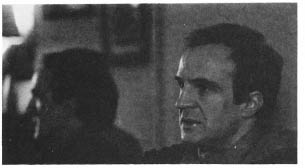
Introduction
Andr Bazinwas born on April 18, 1918, in Angers, and died at the age of forty. For fifteen years he was the best film critic. It would be more accurate to say the best writer about films, since Bazin was more interested in analyzing and describing films than in judging them.
B azin studied at La Rochelle, then entered the Ecole Nationale Suprieure in Saint-Cloud in 1938, where he trained to be a teacher. Drafted into the army in 1939, he became more and more interested in film, and in 1942 became one of the founders of the Groupe Cinma of the Maison des Lettres.* It was at this time that he began to write his first articles in student papers (later published as The Cinema During the Occupation). After the Liberation he became the film critic of Le Parisien Libr, Esprit, then of LObservateur, Radio-Cinma-Tlvision, and later co-editor-in-chief of Cahiers du Cinma. At the same time, Bazin organized Les Jeunesses Cinmatographiques and directed the Cinema Section of Travail et Culture. He presented films at the art theaters and conducted debates with the audience: La Chambre Noire and Objective 48. Wherever films were shown, Bazin was present. He was a man of films: the most admired, most sought after, as well as the most lovedfor he was a strictly moral person who was also tolerant, good, and extraordinarily warm.
* An organization founded to educate young people whose education had been disrupted by the war.
In 1948 he got me my first interesting jobit had to do with films. I worked beside him at Travail et Culture, and from then on Bazin became a sort of adoptive father for me. I can truly say that I am indebted to him for everything good that has happened to me since. Bazin taught me how to write. He corrected and published my first articles in Cahiers du Cinma, and he progressively led me toward directing. He died on November 11, 1958; the day before, I had just begun to shoot my first film, The Four Hundred Blows, of which he had only seen the script. Naturally, the film was dedicated to him. Shortly before his death he had seen perhaps for the tenth time The Crime of Monsieur Lange (1935) on television, after which he immediately wrote several pages that comprise one of the best chapters in his posthumously published Jean Renoir.
Andr Bazin, whose goodness was legendary, was truly a man who antedated Original Sin. Everyone knew him to be honest and generous, but the extent of that honesty and generosity was amazing, and it was constantly lavished not only on friends but also on chance acquaintances. Even an overzealous or abusively bureaucratic policeman was seduced and won over by Bazin after listening to him talk for five minutes. When hearing him speak or argue a point, one witnessed the triumph of right over might.
He had a great heart but was in poor health, which dampened neither his gaiety nor his radiance; Bazin was the embodiment of logic in action, a man of pure reason, and a marvelous dialectician. From the time of his first articles, Bazin called for more mature and responsible film. No one should be telling us that we need films to suit every taste. At this point, we are far beneath taste. Just the opposite is true: the crisis in films is not really based on an aesthetic level but on an intellectual one. Basically, films suffer from such obvious stupidity that aesthetic quarrels are relegated to the background.
Strongly influenced at the onset of his career by Jean-Paul Sartre, Bazin was, as his friend the critic P A. Touchard remarked, a prodigious virtuoso in analysis. His pedagogic sense was widely appreciated. Bazin was, and probably still is, the most translated and published film critic outside France.
When he died in 1958, Bazin left an unfinished manuscript on Jean Renoir, subsequently published in the United States by Simon and Schuster. He had also just finished correcting the proofs of a collection of articles published in four volumes under the title What Is Cinema?, published in America by the University of California Press.
Bazin clearly defined his vocation when he wrote, The critics function is not to present a nonexistent truth on a silver platter, but to prolong to the maximum the shock of the work of art on the intelligence and sensibility of his readers.
In this book I have assembled Bazins writings on six filmmakers who share a very particular style and a subversive way of thinking. Each of them has exercisedor still exercisesa worldwide influence on films. Each film brings out the moralist in the director and makes each of them, beginning with Stroheim, a filmmaker of cruelty.
1. Erich von Stroheim, whose career began as an actor in The Birth of a Nation (1915), is an offspring of D. W. Griffith, as are Carl Dreyer, Jean Renoir, and almost all the directors who, starting in 1918, set out to emulate what was best in silent films. Stroheim, who made only nine films and had to give up directing after the advent of sound (with one brilliant exception), became the symbol of the
Next page
